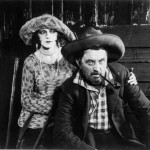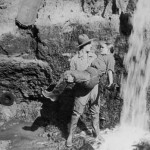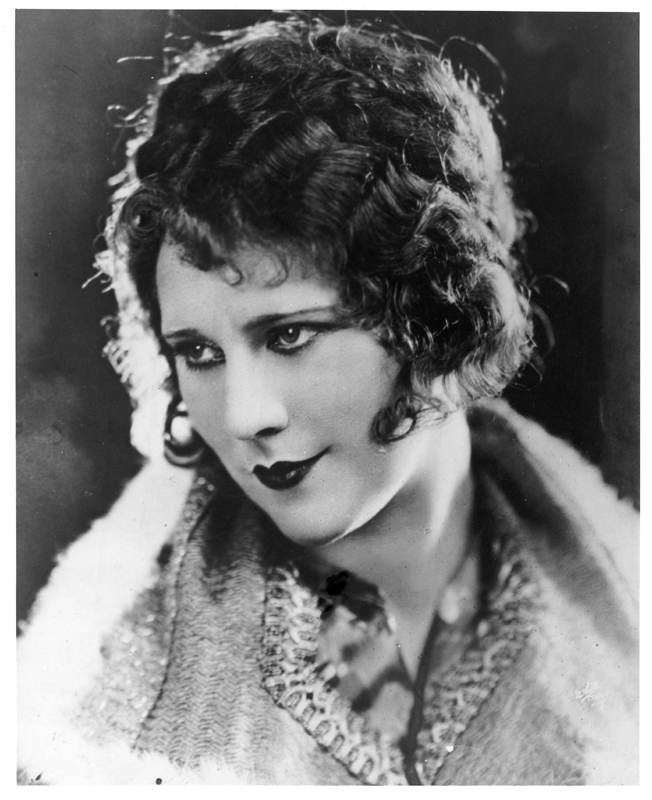by
Jeannette Delamoir
Louise Lovely was an Australian actress who worked in early Hollywood between 1915 and 1922. Although she made ten verified films in Australia and fifty in the United States, few are extant. With scant surviving personal papers, research into Lovely’s oeuvre depends largely on trade journals and star publicity—materials that have limitations as sources. Furthermore, while Australia’s Film and Sound Archive has important collections of Louise Lovely photographs and scrapbooks, trade journals or Hollywood studio records have been difficult to access in Australia. Nevertheless, the available materials reveal Lovely’s struggle to expand her filmmaking beyond performing and to exert control over her career.
After working as Louise Carbasse in stage melodramas and vaudeville in Australasia and the United States, Lovely’s new name and her youthful, blond, Pickford-esque appearance were created by Universal at the end of 1915, apparently as conditions of a contract, Theatre reported in 1916 (27). An issue of Motography from October 1917 reveals that Universal established Louise Lovely Productions, but does not appear to have given her any control over the productions (869). In a 1978 interview with Ina Bertrand, Lovely recalled that she had left Universal in March 1918, following disagreements over wages during which it was revealed that her name, owned by Universal, could legally prevent her working for any other studio. She finally secured a contract at Fox, where she supported husky star William Farnum in Westerns. She made her final US films in 1921, including two for Quality Film Productions. These films were distributed by the recently formed CBC Film Sales Company, which became Columbia Pictures in 1924, and Lovely claimed that she had been invited to join the company board of directors, according to Kathy Kizolos, writing in 1981 (14).
The purported connection with Columbia is further supported by Lovely’s comment in her 1978 oral history that Harry Cohn suggested she tour vaudeville following her second Quality Film Productions film (53). She and first husband Wilton Welch traveled between 1921 and 1925 with “A Day at the Studio,” in which audience members volunteered for on-stage “screen tests” that were screened the following week. The act was popular with hopefuls in movie-struck North America, and then in Australia. Lovely described further to her interviewer that she and Welch shared screen-test directing duties: “He directed me sort of thing, and I directed everybody else…” (54).
The hierarchical tensions between his “masculine” authority and her “lovely”— i.e., feminine—star persona are again evident in her final film, Jewelled Nights, made in Australia in 1925 after she returned from the US. Her role as the face of a public company, Louise Lovely Productions, sat uncomfortably with her “dainty” film persona. In this final film, ironically, she played a socialite who rejects gender and class restrictions by jilting her groom at the altar and, disguised as a man, hiding in a remote all-male mining community.

Louise Lovely, Jewelled Nights, 1926. Courtesy of the National Film and Sound Archive of Australia.

Gordon Collingridge holding Louise Lovely in Jewelled Nights (1926). Courtesy of the National Film and Sound Archive of Australia.
Although Lovely’s profile was featured in the logo for the company, she was credited only with acting and cowriting the scenario for Jewelled Nights (1926). Wilton Welch was credited as director in the press book prepared for exhibitors, but although the extent of her contribution is not precisely known, she claimed in an interview for the Weekender that: “I was virtually the producer. I personally cut and spliced the film. The acting was only part of it.” She also recalled in her 1978 interview that she had worked on the design of, and publicity for the film, as well as on casting. Most importantly, Lovely said that she did at least some of the directing (60) and even claimed to have invented a new type of film syntax: “I said, ‘We won’t have a train and we won’t have a boat, we’ll just have the big funnel of the boat when she’s leaving there, she goes up to the boat, you see, and then we just show the funnel’ … which I thought was a rather good invention, you know” (70–71). The film was financially unsuccessful, possibly partly due to mismanagement by board members; however, the remaining footage, most likely outtakes, shows Lovely’s acting to be in a melodrama style outdated by 1926.
In her move into production, Lovely had had contact with a number of impressive female film pioneers, mainly at Universal. There, she featured in seven films written by Ida May Park and, post-Universal, was directed by Park in a further film. Lovely was also at Universal when Cleo Madison, Lois Weber and Elsie Jane Wilson were directing. Lovely had appeared with Wilson in Bettina Loved a Soldier (1916), which was directed by Wilson’s husband Rupert Julian.
After retiring from the screen, Louise Lovely made at least two attempts to put her Hollywood experience to good use. In her evidence to the 1927 Royal Commission into the Australian Motion Picture Industry, she advised the Australian government to set up a subsidized film studio, and in 1931 she reprised the “Studio Act” vaudeville act for a week at the Melbourne Tivoli.
Bibliography
Delamoir, Jeannette. “Louise Lovely: The Construction of a Star.” Unpublished PhD. Dissertation. La Trobe University, Melbourne, Australia, 2002.
Godfrey, Margaret. “Savage River Could Have Been Our Hollywood.” Weekender (Burnie, Tasmania) (10 April 1968): n.p.
-------. “Jewelled Nights in Toorak Setting: Louise Lovely Ball at ‘Whernside.’” Table Talk (21 May 1925): 8.
Kizilos, Kathy. “Focus on the Stars of Yesterday.” Age [Melbourne, Australia] (6 February 1981): 14.
------. “November Important Month for Bluebird.” Motography (27 October 1917): 869.
Louise Lovely. Interview with Ina Bertrand. Transcript. Hobart, Tasmania, 23 November 1978. National Film and Sound Archive of Australia.
Welch, Wilton. “Louise Makes Good.” Theatre 1 (April 1 1916): 27.
Archival Paper Collections:
A variety of archival materials and photographs are held at the following archives:
Wisconsin Center for Film and Theatre Research.
The George Eastman Museum.
The State University of New York at Purchase Library (Macdonald Film Stills Collection)
Academy of Motion Picture Arts and Sciences, Margaret Herrick Library.
The National Film and Sound Archive of Australia.
The Palm Springs Historical Society.
Filmography
A. Archival Filmography: Extant Film Titles:
1. Louise Lovely as Actress
Fragment. Catalogued: “Short fiction segment, Western, US, c. 1914, Dan Carlyle wanted for bank robbery; other segment” (item no. 67201), cas.: Louise Lovely, si, b&w, approx. 7 min. Archive: National Film and Sound Archive of Australia.
Dolly’s Scoop. Dir.: Joseph De Grasse, sc.: Ida May Park (Rex/Universal Mfg. Co.US 1916) cas.: Louise Lovely, Lon Chaney, si, b&w, 2 reels of 2. Archive: BFI National Archive.
The Grasp of Greed. Dir.: Joseph De Grasse, sc.: Ida May Park (Bluebird/Universal Mfg. Co. US 1916) cas.: Louise Lovely, Lon Chaney, si, b&w, 5 reels of 5. Archive: George Eastman Museum, EYE Filmmuseum
The Social Buccaneer. Dir.: Jack Conway, sc.: Fred Myton (Bluebird/Universal Mfg. Co. US 1916) cas.: Louise Lovely, J Warren Kerrigan, si, b&w, 3 reels of 5. Archive: Library of Congress, Library and Archives Canada.
The Field of Honor. Dir.: Allen Holubar, sc.: Elliot J. Clawson, st.: Brand Whitlock (Butterfly/Universal Mfg. Co. US 1917) cas.: Allen Holubar; Louise Lovely, si, b&w, 6 reels of 5. Archive: Library of Congress.
The Gift Girl. Dir.: Rupert Julian, sc.: EJ Clawson (Elliot J. Clawson) (Bluebird/Universal Mfg. Co. US 1917) cas.: Louise Lovely, Rupert Julian, Wadsworth Harris, si, b&w, 5 reels of 5. Archive: Library of Congress.
The Third Woman/The Innocent Cheat. Dir.: Charles Swickard, sc. J. Grubb Alexander, st.: Raymond L. Schrock (Superior Pictures/Robertson-Cole Distributing Corp. US 1920) cas.: Carlyle Blackwell, Louise Lovely, si, b&w, 5 reels of 5. Archive: Library of Congress, National Film and Sound Archive of Australia.
Heart of the North. Dir.: Harry J. Revier, sc.: Eddie Dowling (Quality Film Productions US 1921) cas.: Roy Stewart, Louise Lovely, Harry von Meter, si, b&w, 6 reels of 6. Archive: Library of Congress, National Film and Sound Archive of Australia.
2. Louise Lovely as Actress, Co-Screenwriter, and Producer
Jewelled Nights. Dir.: Wilton Welch, possible co-director, Louise Lovely; sc.: Wilton Welch, Louise Lovely (Louise Lovely Productions Australia 1926) cas.: Louise Lovely, Gordon Collingridge, Godfrey Cass, si, b&w, 6 minutes of 10,000 feet. Archive: National Film and Sound Archive of Australia.
B. Filmography: Non-Extant Film Titles:
1. Louise Lovely as Actress (as Louise Carbasse)
A Tale of the Australian Bush/Ben Hall the Notorious Bushranger, 1911; One Hundred Years Ago, 1911; A Ticket in Tatts, 1911; The Colleen Bawn, 1911; The Girl from Outback, 1911; Hands Across the Sea, 1912; A Daughter of Australia, 1912 ; Conn the Shaughraun, 1912; The Wreck of the Dunbar/The Yeoman’s Wedding, 1912; The Ticket of Leave Man, 1912; Father and the Boys, 1915.
2. Louise Lovely as Actress (as Louise Welch)
Stronger than Death, 1915.
3. Louise Lovely as Actress
Dolly’s Scoop, 1916; The Grip of Jealousy, 1916; Tangled Hearts/The Altar of Friendship, 1916; The Gilded Spider/The Full Cup, 1916; Bobbie of the Ballet, 1916; Bettina Loved a Soldier, 1916; The Measure of a Man, 1916; Stronger than Steel, 1916; Blood Money, 1917; The Fugitive, 1917; Diamonds of Destiny, 1917; The Outlaw and the Lady, 1917; The Fourth Witness, 1917; The Grip of Love, 1917; Her Great Dilemma, 1917; The Reed Case, 1917; Sirens of the Sea, 1917; The Wolf and His Mate, 1917; Painted Lips, 1918; Nobody’s Wife, 1918; The Girl Who Wouldn’t Quit /The Quest for Joan, 1918; A Rich Man’s Darling, 1918; Life’s a Funny Proposition, 1919; Johnny on the Spot, 1919; The Man Hunter, 1919; The Usurper, 1919; The Lone Star Ranger, 1919; The Wolves of the Night, 1919; The Last of the Duanes, 1919; The Wings of Morning, 1919; The Butterfly Man, 1920; The Orphan, 1920; The Twins of Suffering Creek, 1920; The Joyous Troublemakers, 1920; The Skyway Man, 1920; The Little Grey Mouse, 1920; Partners of Fate, 1921; While the Devil Laughs, 1921; The Old Nest, 1921; Poverty of Riches, 1921; Life’s Greatest Question, 1921; Shattered Idols/ Bride of the Gods, 1921; A Day at the Studio, 1923.
Research Update
June 2020: Research conducted by Australian historians Stephen and Louise Dando-Collins links Louise Lovely to one additional film (as actress), Her Strange Experience (US, 1917), which appears to be a lost 1-reeler. According to their research, the film was produced by IMP and released on June 17. It was directed by Maxwell Ryder, and written by Ryder and Jack Cunningham, from a story by Eugene B. Lewis.
Their research also indicates that Painted Lips (1918) was connected to the Louise Lovely Productions banner in the US, as was A Day at the Studio (shot at CBC's Triangle Studio in Los Angeles), which was co-produced by Louise Lovely Productions (and Louise was the co-writer as well as star/presenter). They also credit her as producer on: Sirens of the Sea (1917), Nobody's Wife (1918), The Girl Who Wouldn't Quit (1918), and A Rich Man's Darling (1918), although her "producer credit" on the this last title was reportedly removed by Carl Laemmle.
Citation
Delamoir, Jeannette. "Louise Lovely." In Jane Gaines, Radha Vatsal, and Monica Dall’Asta, eds. Women Film Pioneers Project. New York, NY: Columbia University Libraries, 2013. <https://doi.org/10.7916/d8-zwzy-qe67>



